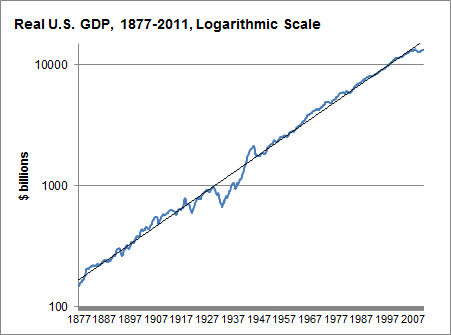I was reading a post on the economy from the political statistics blog FiveThirtyEight, and the following graph shocked me:

This, according to Nate Silver, is a log-scaled graph of the GDP of the United States since the Civil War, adjusted for inflation. What amazes me is how nearly perfect the linear approximation is (representing exponential growth of approximately 3.5% per year), despite all the technological and geopolitical changes of the past 134 years. (The Great Depression knocks it off pace, but WWII and the postwar recovery set it neatly back on track.) I would have expected a much more meandering rate of growth.
It reminds me of Moore's Law, which would be amazing enough as a predicted exponential lower bound of technological advance, but is staggering as an actual approximation:

I don't want to sound like Kurzweil here, but something demands explanation: is there a good reason why processes like these, with so many changing exogenous variables, seem to keep right on a particular pace of exponential growth, as opposed to wandering between phases with different exponents?
EDIT: As I commented below, not all graphs of exponentially growing quantities exhibit this phenomenon- there still seems to be something rather special about these two graphs.


GDP trend related to population, not to previous GDP? Over the period of time covered by the above GDP graph, the log graph of US population (seen on http://www.wolframalpha.com/input/?i=united+states+population) looks pretty much like a straight line. GDP per person looks exponential over the last ~60 years (also wolframalpha) [edit] looks linear in constant dollars (from wikipedia)[/edit]
Unless an economic disruption is big enough to greatly change the birth or death rates, the GDP will tend to go back to the straight line, it seems.
If there is easy-to-find GDP data going back to the 1600s, when the log(population) graph is not on the same line as recently, my guess could be tested.
Alternatively, we could examine both datasets closely to see if non-trend-predicted variation in one is reflected in the other.